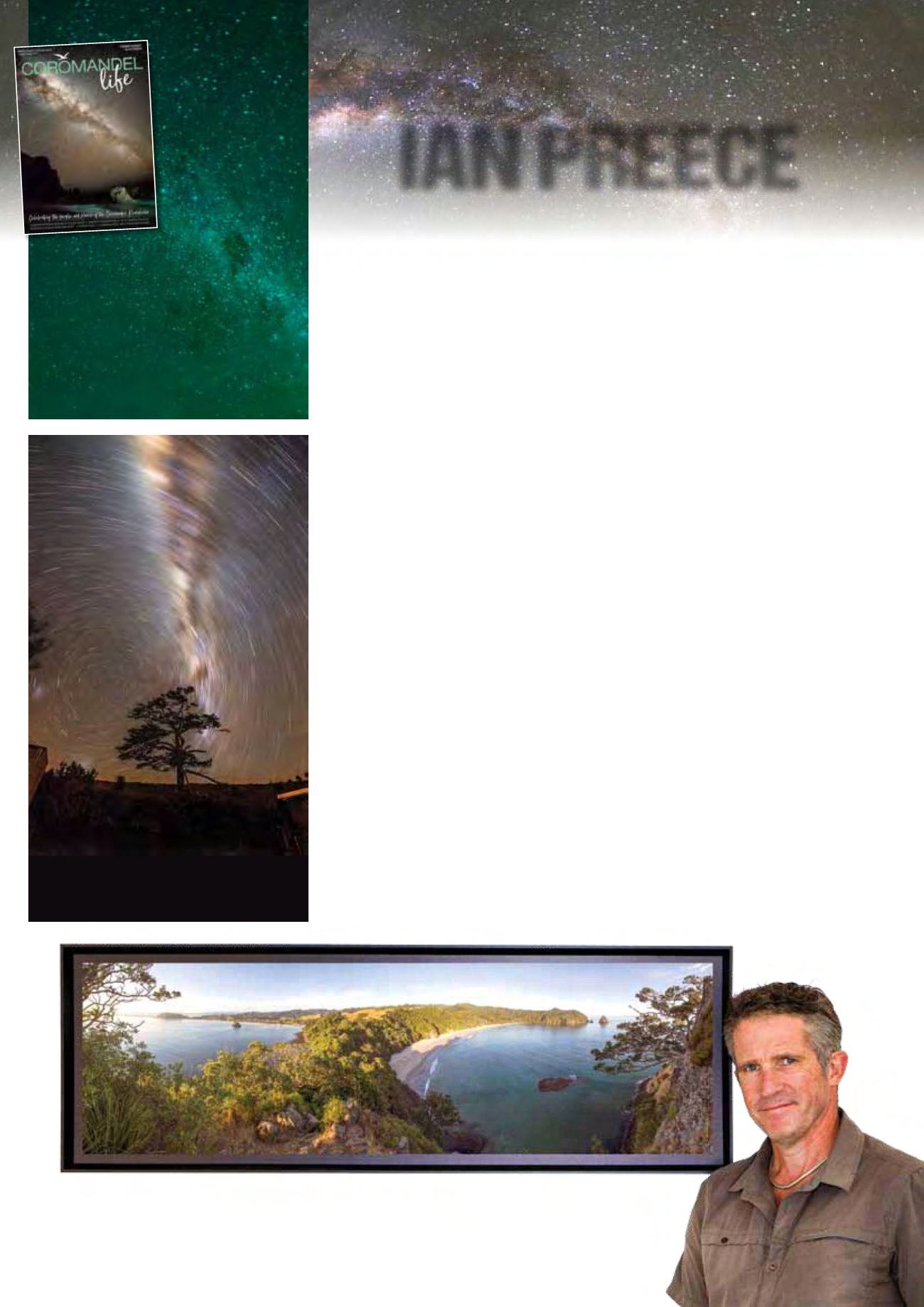

Our cover artist...:
IAN PREECE
SHOOTING FOR THE STARS
“The unsociable hours aside, taking pictures of
the stars is one of the most rewarding areas of
photography I am currently involved in,” states
Coromandel photographer Ian Preece.
“Cameras have the ability to ‘see’ even more
stars and more colours than the naked eye,
so when I view my final photos later it’s like
opening a window into a new world – a world
that has fascinated man for many thousands of
years, leading us to contemplate the nature of
our existence and place in the universe.”
For those living here, it might be easy to take
our clear night skies and stunning views of the
Milky Way for granted, but not for Ian.
“As someone who has photographed around
the world, I marvel at the unique quality of the
night skies in NZ – something that continues to
amaze. There is an intensity and clarity rarely
seen in other countries.
“We are particularly blessed here on the
Coromandel where almost perfect conditions
make it ideal for astrophotography. It is one of
the reasons I really appreciate living here.
“Winter is special because of clearer light and
longer nights giving even more opportunities
to capture the moon and stars. There is
something very special about capturing images
of the Milky Way in all its glory.”
Ian describes himself principally as a “nature
photographer focusing on all aspects of the
natural environment – forests and rivers,
birdlife, sea and landscapes – much of which is
unique to NZ”. And he photographs it all, from
the tiniest flowers and insects to those ‘bigger
than life’ night skies.
THE ART OF ASTROPHOTOGRAPHY
Technically, star photography is very different
to photographing at other times of day”, shares
Ian. “The lack of light, focussing and managing
exposure within the camera are all challenging,
but well worth the effort.”
For people interested in exploring this unique
and exciting world, Ian offers courses and
on-location workshops on astrophotography as
well as other aspects of nature photography.
“The camera, lens and tripod have to be up
to the job”, he says, “but I have equipment
available for use if needed.
“As with any type of digital photography,
a certain amount of image processing is
required. To do this, I use (and teach) a simple
process in Photoshop – as I like to spend as
much time behind the camera as possible.”
ABOUT THE ARTIST
Ian and his partner Shirley have owned land in
Kuaotunu since 2005, and their commitment
to the environment runs even deeper than
photographing it. “We have placed most of
the 45 acres in QE2 covenant and have been
replanting for over 12 years. We have a host
of native birds, including kiwi.” The covenant
provides permanent protection of private land,
regardless of who owns it.
Ian’s interest in photography started in his
early travels when he purchased his first
35mm film camera. He later partnered with
Searching for a cover image for this off-season edition – we wanted to find an appealing
image that represented Winter yet was dramatic and inspiring. When we saw Ian’s
recent images of the Coromandel Night Skies we knew we’d found the perfect cover.
However, the problem lay in which one – the entire team struggled with choosing from
the dramatic night scenes Ian had captured.
Once our interests had been aroused, we investigated the magic and mystery in night
time photography. This led to our centre spread article on Astrophotography, a growing
passion for many, and a popular outdoor winter activity!
About
OTAMA ROCKS
“It was a particularly
dark moonless night
when I set out for
Otama Beach at
around 11pm last
winter. The sky was
very clear and the
patterns of the stars
in the Milky Way
were particularly noticeable. This was my
pick of the set of images from that night
– capturing the stunning sky and those
recognisable ‘Otama Rocks’.
“This is one of my favourite locations for
workshops. I have photographed this
same beach and rocks at many different
times during the day, and it has such a
different feel at nighttime.”
“I normally prefer star shots to be point sources but
if you open the shutter for longer – say 3 hours – you
can get some really interesting star trail effects.”
This photo of the Milky Way was shot in 2014
at Kuaotunu around 2am.
8
COROMANDEL LIFE 2018 WINTER/EARLY SPRING
‘New Chum Beach’ hangs in
Ian Preece’s Kuaotunu studio.
















